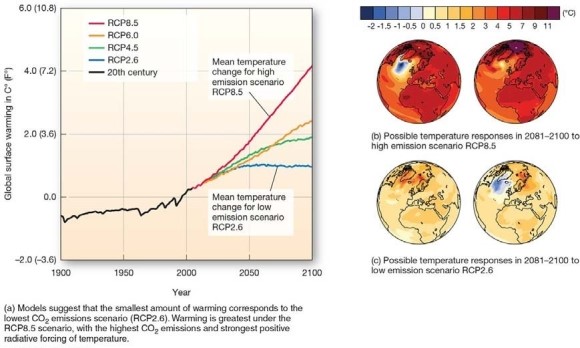B) False
Correct Answer

verified
Correct Answer
verified
True/False
Halogenated gases are purely anthropogenic and have no natural sources.
B) False
Correct Answer

verified
Correct Answer
verified
Multiple Choice
Fossil fuel burning accounts for over________ percent of CO2 emissions.
A) 20
B) 50
C) 70
D) 85
F) B) and C)
Correct Answer

verified
Correct Answer
verified
True/False
The majority of human population growth is now occurring in more-developed countries (MDCs).
B) False
Correct Answer

verified
Correct Answer
verified
Multiple Choice
 -According to the RCP8.5 scenario of high emissions
-According to the RCP8.5 scenario of high emissions
A) global surface temperatures will increase until about mid-century,then steadily decrease.
B) global surface temperatures will increase throughout the 21st century,but at a very gradual rate.
C) global surface temperatures will cool during the most of the 21st century.
D) global surface temperatures will increase throughout the 21st century,perhaps by as much as 4°C (7.2°F) by 2100.
F) A) and D)
Correct Answer

verified
Correct Answer
verified
True/False
Carbon dioxide (CO2)is the most abundant natural greenhouse gas.
B) False
Correct Answer

verified
Correct Answer
verified
True/False
The Paleocene-Eocene Thermal Maximum (PETM)is characterized by some of the coolest temperatures in Earthʹs history.
B) False
Correct Answer

verified
Correct Answer
verified
Multiple Choice
The IPCC Fifth Assessment Report concludes
A) that while climate change is occurring,it is largely natural climate fluctuations.
B) humans are likely (95% certainty) responsible for the temperature increase from 1951 to 2010.
C) it is highly doubtful that recent climate trends represent anything more than a temporary perturbation in the long-term climate signal.
D) there is no consensus on recent climate trends; some maintain it is mostly human-caused,others maintain it is natural fluctuations.
F) B) and C)
Correct Answer

verified
Correct Answer
verified
Multiple Choice
General circulation models (GCMs) of the atmosphere
A) are highly simplistic models that use one or two variables to test the veracity of climate proxies,such as ice core and ocean sediment core samples.
B) are based on statistical three-dimensional grids that characterize portions of the atmosphere and ocean in terms of climate-related variables.
C) are pre-computer based models that estimated atmospheric and oceanic circulation and are now being used to study climate change.
D) calculate the concentrations of greenhouse gases in the atmosphere based on data from weather stations located around the globe.
F) A) and B)
Correct Answer

verified
Correct Answer
verified
Multiple Choice
Milankovitch cycles refer to
A) tectonic changes in continental position and topographic changes from orogeny,erosion,and mass wasting.
B) increases and decreases in atmospheric gases and aerosols,primarily caused by natural activity such as volcanic activity and changes in net primary productivity.
C) changes in Earthʹs orbit,axial rotation,and axial tilt.
D) cyclical changes in solar irradiance caused by increases and decreases in sunspot activity.
F) None of the above
Correct Answer

verified
Correct Answer
verified
Multiple Choice
Of the following anthropogenic methane (CH4) sources,which is the largest?
A) Livestock
B) Rice paddies
C) Wastewater treatment
D) Agriculture associated fires
F) A) and C)
Correct Answer

verified
Correct Answer
verified
Multiple Choice
The last interglacial period with temperatures similar to the present interglacial period was the
A) Eemian interglacial.
B) Günz-Mindel interglacial.
C) Holstein interglacial.
D) Flandrian interglacial.
F) None of the above
Correct Answer

verified
Correct Answer
verified
Multiple Choice
A lower 18O/16O ratio in ocean sediment cores indicates a________ climate,whereas a higher 18O/16O ratio indicates a ________climate.
A) cooler; cold
B) cooler; warmer
C) warmer; cooler
D) warmer; hot
F) A) and C)
Correct Answer

verified
Correct Answer
verified
True/False
GCMs are used to predict specific temperatures in the near and long -term future.
B) False
Correct Answer

verified
Correct Answer
verified
Multiple Choice
The________ is a graph which plots monthly averages of CO2 concentrations since 1958.
A) MCA
B) Younger Dryas
C) Keeling Curve
D) PETM
F) A) and C)
Correct Answer

verified
Correct Answer
verified
True/False
Over the last two decades,the Antarctic ice sheet has lost mass.However,the Greenland ice sheet has actually gained mass due to increased winter precipitation.
B) False
Correct Answer

verified
Correct Answer
verified
Multiple Choice
Changes in Earthʹs orbital configuration may lead to warming temperatures.These warming temperatures,in turn,may lead to the release of both CO2 and CH4.Increases in these gases may further warm the planet.This is an example of a
A) positive feedback loop.
B) negative feedback loop.
C) neither a positive or negative feedback loop.
E) A) and B)
Correct Answer

verified
Correct Answer
verified
True/False
The last glacial maximum (LGM)refers to the duration of the last period of glaciation.
B) False
Correct Answer

verified
Correct Answer
verified
True/False
Recent temperature increases correspond to a period of increased sunspot activity.
B) False
Correct Answer

verified
Correct Answer
verified
Multiple Choice
 -Over the span of 70 million years,Earthʹs climate
-Over the span of 70 million years,Earthʹs climate
A) was warmest approximately 10 million years ago and coolest about 56 million years ago.
B) has remained fairly constant,only showing a warming trend during the past 200 years.
C) was much cooler in the distant past than the present.
D) was much warmer in the distant past than the present.
F) B) and C)
Correct Answer

verified
Correct Answer
verified
Showing 61 - 80 of 137
Related Exams